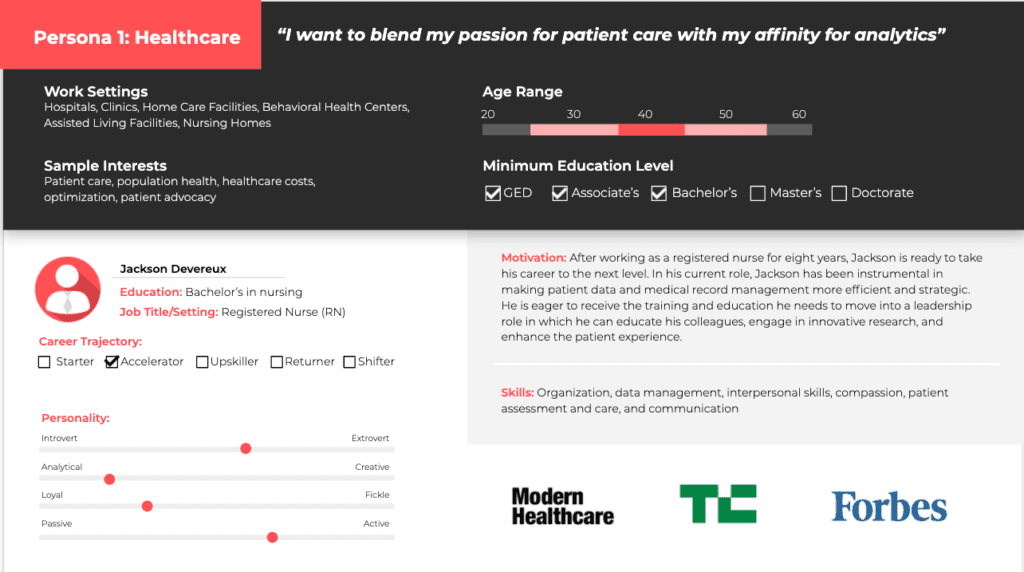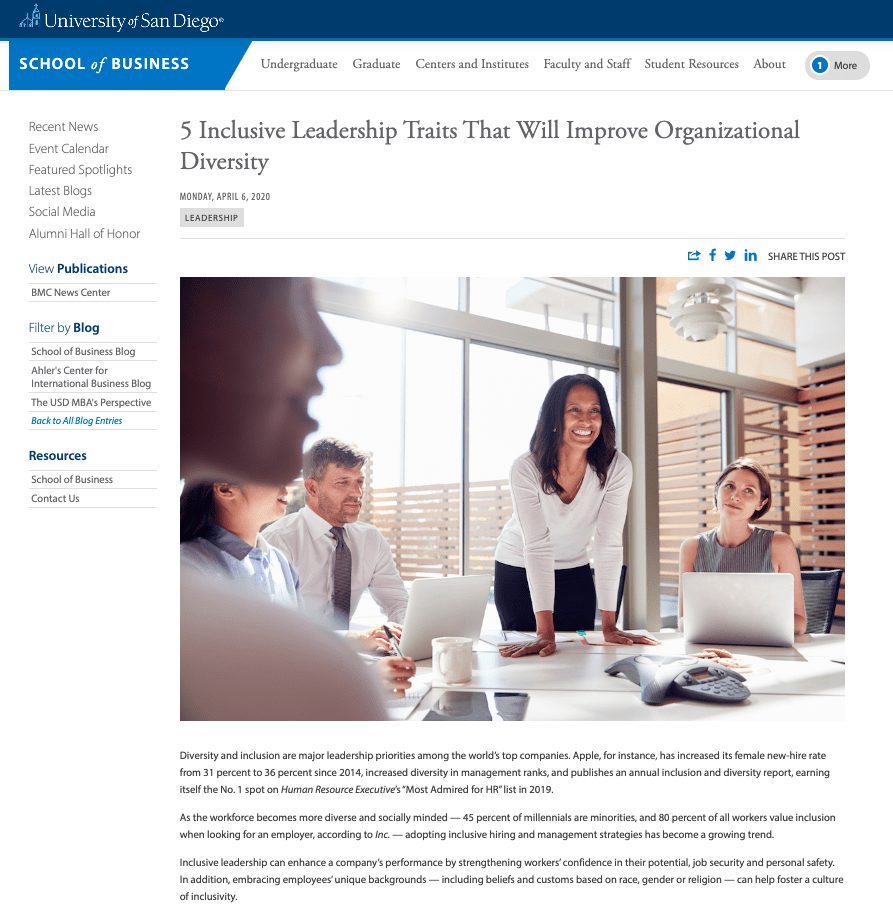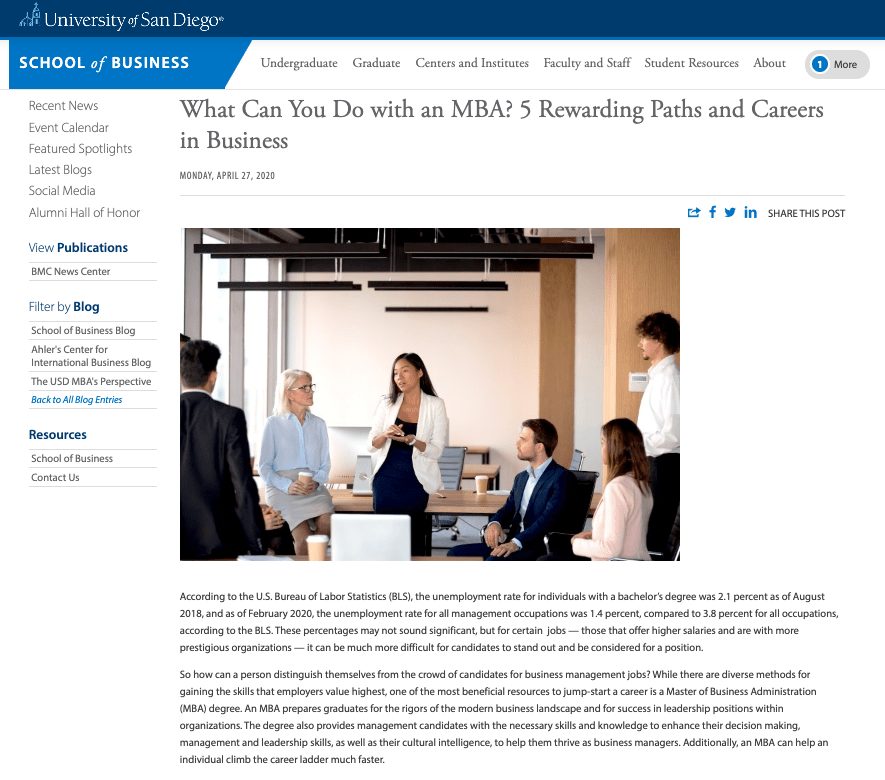How to Create Content for Business School Marketing
For business schools, content marketing can be an effective way to build trust and make meaningful connections with potential students and other audiences.
Content marketing is the art of using creative storytelling to amplify a message or encourage a desired action. This doesn’t have to be the “once upon a time” type of storytelling — it can take a variety of forms, ranging from individual articles to entire publications. Blogs, infographics, podcasts, videos, social media posts, and email newsletters can all be vehicles for content marketing.
As competition for qualified applicants heats up, business schools are employing creative solutions to distinguish themselves and meet their enrollment goals. These institutions have a stockpile of resources that put them in a unique position to create genuinely interesting content. They can draw from faculty expertise, highlight student and alumni stories, and tap into a vast store of knowledge that has a range of practical, real-world applications. There’s also a built-in value proposition: This content can teach you something and maybe even help you become more successful.
At Archer, we develop content strategies that help our business school clients gain visibility and leave a positive impression on the audiences that matter most to them. To achieve that goal, we need to understand what makes the school special, what stories it wants to tell, and whom it hopes to reach.
We’d like to share five content marketing tips for business schools inspired by our experience in this area.
1. Define Your Audience
The first step in crafting an effective content marketing strategy is to determine whom you intend to reach.It’s typically not enough to simply declare that your audience is “MBA candidates” or “aspiring business professionals.” While those groups may be important, the power of content marketing lies in the ability to drill down and target specific readers, viewers, and listeners based on their backgrounds, interests, and other characteristics.
So how can you get to know these people?
Audience Discovery and Personas for Business School Marketing Content
 One way to learn more about your potential reader base is to conduct direct outreach with actual members of the school community. This can help you gauge interest in specific topics as you continue to refine your content strategy. It’s also a great way to make connections and learn some surprising things that you might otherwise miss.
One way to learn more about your potential reader base is to conduct direct outreach with actual members of the school community. This can help you gauge interest in specific topics as you continue to refine your content strategy. It’s also a great way to make connections and learn some surprising things that you might otherwise miss.
When Archer begins working with a new client, we often organize on-site roundtable discussions with students, alumni, professors, and administrators to hear directly from these stakeholders about their academic interests and professional goals, as well as the factors that drew them to that particular program. It’s also helpful to ask participants for specific examples of publications and other content platforms that they consider interesting and trustworthy.
Using the information you gather through discovery and other outreach efforts, you can then create personas that align with the university’s branding efforts that represent the major categories of prospective students who make up your core marketing audience.
2. Tie Your Content Goals to the Enrollment Funnel
Once you know which personas you’d like your content to reach, you’ll need to set some measurable content marketing goals. You can start to identify these goals by asking two questions: What message do you want to send, and what actions do you want the reader, viewer, or listener to take?Examples of Common Business School Content Goals
While business school content marketing goals largely depend on the target audience, most institutions ultimately hope to achieve the following objectives:
- Reputation enhancement: Raise awareness and create a favorable impression of the school.
- Lead generation and conversions: Encourage potential students to provide information about themselves so they can learn more about the program.
- Enrollment: Persuade prospective students to apply to the program.
From here, it’s a matter of priorities. If you’re zeroing in on the second and third goals — which focus more on direct engagement with prospective students — your content will likely look a bit different than it would if you were pursuing the first, which casts a wider net in terms of audience.
Content Marketing and the Enrollment Funnel
 The world of higher-ed marketing revolves around the concept of the enrollment funnel, which depicts a future student’s gradual journey from awareness to enrollment. The funnel is divided into tiers, each of which represents a phase of the decision-making process. At Archer, we refer to these tiers as awareness, familiarity, consideration, and choice, but the labels can vary depending on whom you ask.A good content marketing strategy reflects the shifting needs, priorities, and mindsets of future students as they move through each tier of the funnel:
The world of higher-ed marketing revolves around the concept of the enrollment funnel, which depicts a future student’s gradual journey from awareness to enrollment. The funnel is divided into tiers, each of which represents a phase of the decision-making process. At Archer, we refer to these tiers as awareness, familiarity, consideration, and choice, but the labels can vary depending on whom you ask.A good content marketing strategy reflects the shifting needs, priorities, and mindsets of future students as they move through each tier of the funnel:
- Top-of-funnel content should be relevant to prospective students while also appealing to broader audiences with similar interests.
- Mid-funnel content should be more tailored to prospective business school students. Rather than excessively promoting your school, it should get the audience thinking about the benefits of enrolling in a business school program and imagining their paths to success if they enroll in a program like yours.
- Bottom-of-funnel content targets readers who are close to deciding which school they’d like to attend. To convert leads into applicants, this content typically includes a more overt pitch for the school’s programs and a prominent call to action.
Next, we’ll provide some tips for crafting different types of content according to the typical goals and audiences associated with each level of the funnel.
3. Top-of-Funnel Content: Tell an Interesting Story

- Enrollment funnel levels: Awareness and familiarity
- Typical audience: Prospective students and a variety of other potential audiences
- Goals: Reputation enhancement and information sharing
- Effective content types: Informational content and infographics and multimedia
Regardless of format or audience, higher-ed marketing content should tell a good story and make the reader feel smarter after consuming it. This is especially true of content at the top of the funnel, which is all about sharing information while raising general awareness about your school or program.
While prospective students are the ultimate target for business school marketing content, they’re not the only audience you can reach — now is the time to think big. In addition to courting future applicants, business schools may also offer publications that speak to a broader external audience of industry leaders, journalists, potential donors, or everyday consumers who read publications such as Fast Company or Harvard Business Review.
This article on inclusive leadership traits that improve organizational diversity, which Archer created for the USD School of Business, is an example of top-of-funnel informational content that tells a compelling story.Infographics and multimedia content are also well suited for promoting engagement with a broader business audience. Visual elements often attract more attention than words alone, and an interesting, stylish presentation helps present the school in a dynamic way. A snappy infographic, such as this one about leadership lessons from revolutionary entrepreneurs, can also be widely shared on social media, supporting the central top-of-funnel goal of awareness.
Informational content should leave the audience with a positive impression, but keep in mind that you’re looking to win over readers who might not be familiar with your program just yet. They need to know that the information you’re providing is authentic and trustworthy, meaning it’s generally best to avoid a hard sell at this stage of the funnel.
4. Mid-Funnel Content: Provide Value

- Enrollment funnel levels: Familiarity and consideration
- Typical audience: Potential students who are starting to think about pursuing a business degree
- Goals: Lead generation and conversions
- Effective content types: Service pieces, alumni stories, and social content
Content aimed at the middle of the funnel should provide a clear value to aspiring business school students, inviting them to become more familiar with your program. An understanding of your student personas becomes more important at this level.
Service content — which features helpful tips, “how-to” guides, and other types of useful information — often works well for engaging a mid-funnel audience. Career guidance is a common theme in business school service pieces. For example, this blog article, which Archer created for the USD School of Business, explains the value of an MBA by outlining five rewarding career paths for MBA graduates. Future business school students might also be interested in articles that explain processes such as applying for graduate programs or setting professional goals.
Service pieces are most effective if they can stand the test of time. Evergreen content that remains relevant from year to year can help an institution establish long-term thought leadership.
Alumni stories are often associated with the bottom end of the enrollment funnel because they tend to be somewhat promotional, but they can also serve a purpose earlier in the student journey by pulling the reader closer to the realm of familiarity.
An article that compares and contrasts two types of business degrees or specific business career tracks is a common example of informational content that targets the lower half of the enrollment funnel.
5. Bottom-of-Funnel Content: Invite the Audience to Learn More
- Enrollment funnel levels: Consideration and choice
- Typical audience: Prospective students on the verge of selecting a business school
- Goal: Applications and enrollment
- Effective content types: Faculty expertise and program-focused content
Marketing content at the bottom of the business school enrollment funnel should spotlight your program’s strengths. Be direct and let the audience know who you are and what you’re all about.
A high-caliber faculty is a big draw for aspiring business students who want to feel confident that they’ll receive a top-tier education. This is why it’s important to tell stories that leverage faculty expertise to illustrate some specific ways in which the school is making a difference in the real world.For example, this video for the USD School of Business showcases the expertise of business school faculty. Incorporating the voices of professors into your content marketing mix can add gravitas and inspire the audience to learn more about what your school has to offer.[vc_video link=”https://www.youtube.com/watch?v=wD1hpFuCrOo&feature=youtu.be” el_aspect=”235″]
Key Takeaways for Business School Marketing Teams
A well-conceived content marketing strategy is essential for business schools looking to meet enrollment goals in today’s competitive environment.It’s especially important to pinpoint the right audience and convince prospective students that your program is right for them. To accomplish these goals, you’ll need to tell a story that demonstrates the value of your school, showcases its personality, and teaches the audience something new.
Content marketing is what Archer Education does. Our team of writers, editors, designers, and SEO experts work together to create dynamic content that resonates with your audience.
Please contact us or visit our Brand and Content Development page if you have any questions or would like to discuss how we can help support you.



